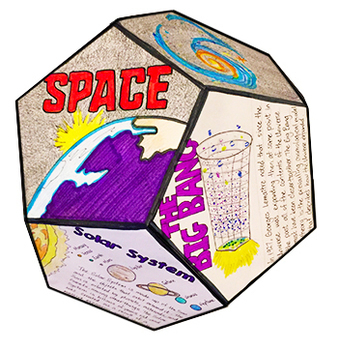Space Project Craft Activity - STEM - PBL
- Zip
What educators are saying
Description
If you would like to purchase the 100% EDITABLE version of this product, click here!
Engage your students in project-based learning!
The boundless, mysterious, and largely unexplored void that is known as Space has fascinated human beings for thousands of years. From The Big Bang to the possibility of life on Europa (a moon of Jupiter), what we learn about our universe helps us understand our place within it.
For this project, students complete 12 activities related to Space (The Big Bang, The Universe, Nebulae, Stars, Galaxies, Black Holes, The Solar System, Planets, The Sun, Meteors & Comets) and construct a 12-sided polyhedron called a Dodecahedron to showcase their learning. These can be hung from the ceiling and are beautiful on display.
For each pentagon, students are asked to answer the guiding questions and complete the challenges through conducting research. To communicate their learning, students write and draw pictures within each pentagon. After completing the 12 pentagons, students follow step-by-step instructions to construct their dodecahedrons.
This Project Package Includes:
- Title Page
- Thank you / Copyright Page
- Project Rationale
- Step by Step Instructions
- How To Conduct Research Page
- How To Avoid Plagiarism
- Research Notes Page
- Pentagon #1 - Title Page
- Pentagon #2 - The Big Bang
- Pentagon #3 - The Universe
- Pentagon #4 - Nebulae
- Pentagon #5 - Stars
- Pentagon #6 - Galaxies
- Pentagon #7 - Black Holes
- Pentagon #8 - Solar System
- Pentagon #9 - Planets
- Pentagon #10 - The Sun
- Pentagon #11 - Meteors & Comets
- Pentagon #12 - Reference List
- Dodecahedron Construction Page (w/ Photos)
- Reference List Instructions
- Project Example Photos
- Student Self-Assessment Write-Up (2-pages)
- Project Rubric
Project-Based Learning (PBL) is a student-centered pedagogy in which students are challenged to actively learn about a subject for an extended period of time. It is a form of active learning or inquiry-based learning. Project-Based Learning is in contrast to paper-based, rote memorization, or teacher-led instruction that presents established facts. Please be aware of what you are purchasing.
Thanks so much,
Creative Lab
_____________________________________________________________________________________________________
Your Feedback = Free Products
We love your feedback. To thank you for your input we want to give you a free resource. Email us at creativelab25@gmail.com with the following info: product name, your feedback, and the product you would like to have for free (excludes bundles). We look forward to hearing from you!
Followers Get Premium Access
• Look for the green star next to our store logo at the top right corner of this page and click it to become a follower. This will allow you to be notified each time we debut a new product or freebie!
Tags: Space, Space Project, Craft, Space Craft, Space Activity, Space STEM





